【跨文化交流英语期末考试】
大学生英语跨文化交际复习题库
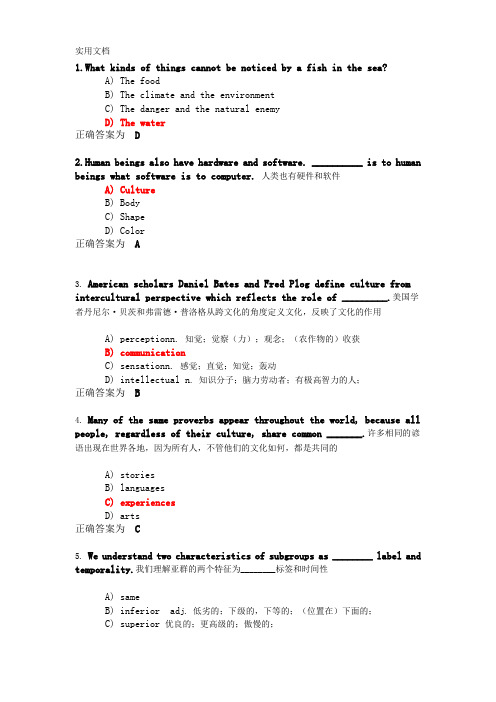
1.What kinds of things cannot be noticed by a fish in the sea?A) The foodB) The climate and the environmentC) The danger and the natural enemyD) The water正确答案为D2.Human beings also have hardware and software. __________ is to human beings what software is to computer. 人类也有硬件和软件A) CultureB) BodyC) ShapeD) Color正确答案为A3.American scholars Daniel Bates and Fred Plog define culture from intercultural perspective which reflects the role of _________.美国学者丹尼尔·贝茨和弗雷德·普洛格从跨文化的角度定义文化,反映了文化的作用A) perceptionn. 知觉;觉察(力);观念;(农作物的)收获B) communicationC) sensationn. 感觉;直觉;知觉;轰动D) intellectual n. 知识分子;脑力劳动者;有极高智力的人;正确答案为B4.Many of the same proverbs appear throughout the world, because all people, regardless of their culture, share common _______.许多相同的谚语出现在世界各地,因为所有人,不管他们的文化如何,都是共同的A) storiesB) languagesC) experiencesD) arts正确答案为C5.We understand two characteristics of subgroups as ________ label and temporality.我们理解亚群的两个特征为________标签和时间性A) sameB) inferior ad j. 低劣的;下级的,下等的;(位置在)下面的;C) superior 优良的;更高级的;傲慢的;D) deviant 不正常的,异常的;离经叛道的正确答案为D6.__________ refers to one’s sense of belonging to a particular culture or ethnic group. It means one’s sense of the culture to which one belongs.指一个人对某一特定文化或民族的归属感。
2005-2006学年春季学期大学英语跨文化交际课程期末试题...
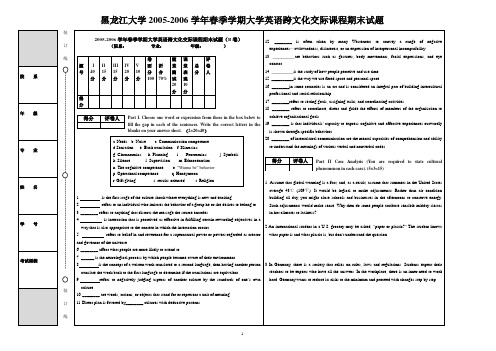
装
2005-2006 学年春季学期大学英语跨文化交际课程期末试题(B 卷) 学年春季学期大学英语跨文化交际课程期末试题(
订 线 题 号 I 40 分 II 15 分 III 15 分 IV 20 分 V 10 分 (院系: 院系: 专业: 专业: 卷 面 分 100 随 堂 测 试 20 分 课 堂 表 现 10 分 年级: 年级: 评 卷 人 )
院
系
折 合 70%
总 分
得 分 年 级
得分
评卷人
Part I. Choose one word or expression from those in the box below to fill the gap in each of the sentences. Write the correct letters in the blanks on your answer sheet. (2×20=40) ) c. Communication competence j. Symbols
1. Assume that global warming is a fact, and, as a result, assume that summers in the United States average 43℃ (109℉). It would be logical to make adjustments: Rather than air condition building all day, you might close schools and businesses in the afternoons to conserve energy. Such adjustments would make sense. Why then do some people attribute sensible midday siestas in hot climates to laziness? 2 An international student in a U.S. grocery may be asked, “paper or plastic?” The student knows what paper is and what plastic is, but don’t understand the question.
跨文化交际(英语)

跨文化交际课程教学大纲一、课程的基本信息适应对象:英语专业本科四年级学生课程代码:07007926学时分配:30赋予学分:2先修课程:《普通语言学》、《英美概况》、《英美文学史》、《欧洲文化入门》后续课程:二、课程性质与任务当今世界发生的翻天覆地的变化使社会对外语人才的需求也相应提高。
近年来对交际能力的要求除听、说、读、写四种语言运用能力外,还需要具备社会文化能力,即文化素养。
《跨文化交际学》是外语专业本科四年级的任意选修课程。
它以促进学生整体素质发展为根本,注重学生在技能、知识、情感、策略和文化素质等各方面的综合发展。
作为一门新兴学科,《跨文化交际学》集社会语言学、文化语言学、语用学、翻译学、传播学、人类学、外语教学等领域的研究成果于一体,着重文化与交际过程以及文化对交际过程的影响,从而提高外语学习者对文化的敏感和跨文化交际的能力。
《跨文化交际学》除研究文化的定义与特点、交际的定义与特征以及文化与交际的关系外,着重讨论干扰交际的文化因素。
这些因素包括语言、非语言手段、社会准则、社会组织、价值观等。
其中,语言包括词语的文化内涵、篇章结构、逻辑思维以及翻译等值等方面;非语言手段包括手势、身势、服饰、音调高低、微笑、沉默、对时间与空间的不同观念等;社交准则泛指人们交往中必须遵循的各种规则以及某些风俗习惯;社会组织指家庭中各成员的关系、同事朋友关系、上下级关系等;价值观念包括人与自然的关系、宗教观念、道德标准以及人生观、世界观等。
语言是文化的载体,不同文化背景的人们从事交际势必会遇到文化差异的问题。
因此,研究跨文化交际、深入了解语言、文化与交际之间的关系,不仅对于语言研究者,而且对于将要从事外语教学、翻译和外事工作的外语专业的学生是十分必要和大有裨益的。
三、教学目的与要求同英语国家的人们用英语进行有效的交际是学习英语的重要目的之一。
然而有效的交际不仅仅是一个语言技巧问题,还涉及到许多文化因素。
本课程要求学生掌握文化的定义和特征,交际的定义和特征,影响跨文化交际活动的各种因素、跨文化交际的途径以及跨文化交际学的研究方法等。
跨文化思想交流英语_南京理工大学2中国大学mooc课后章节答案期末考试题库2023年
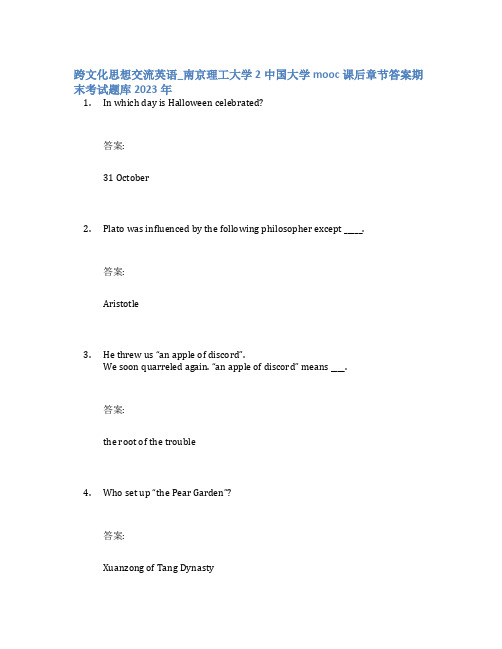
跨文化思想交流英语_南京理工大学2中国大学mooc课后章节答案期末考试题库2023年1.In which day is Halloween celebrated?答案:31 October2.Plato was influenced by the following philosopher except _____.答案:Aristotle3.He threw us “an apple of discord”.We soon quarreled again. “an apple of discord” means ____.答案:the root of the trouble4.Who set up “the Pear Garden”?答案:Xuanzong of Tang Dynasty5.Which of the following does not belong to “Abrahamic religions”?答案:Buddhism6.As soon as a student gains their _________ they instantly become a Dan Gradeand receive their 1st Dan black belt.答案:black belt7.Yan Di was the leader of the tribe of Jiang in ancient China. In order to thankhim for bringing f ood and clothing to the people, people called him “ _____ ”.答案:Shennong8.The architecture of Ancient Rome grew out of that of __________.答案:Greece9.The original New Testament was written in _____.答案:Greek10.The Easter egg and hare, two of the symbols most frequently associated withEaster, are considered to represent _____.答案:fertility and new life11.Generally speaking, in terms of thought patterns, the West follows______,while the East follows _____.答案:analytic and abstract thinking, synthetic and concrete thinking12.Prometheus stole ______for mankind in open defiance to the decrees of Zeus,and was chained to the cliffs of Caucasus Mountains and exposed to horrible tortures.答案:fire13.___ is the biggest and most well-known church in London.答案:St. Paul’s Cathedral14.Confucius’ birth date is believed to fall on _____.答案:Sept. 2815.The differences of synthetic thinking and analytical thinking can also beshown in the following specific fields except for _____.答案:music16.The popularity of ballet soared in _____.答案:Russia17.The term "Gothic" originally referred to the Gothic tribes of the Teutonicpeople who lived in_________.答案:northern Europe18.The Martial Arts we recognize today as Kung Fu had their origins in the________Dynasties.答案:Shang and Zhou19.Chinese characters are a kind of hieroglyphics, and it is said that Chinesecharacters are made by _______.答案:Cangjie20.As to the Man-Nature orientation, the traditional Western belief emphasizes_____, while the Asian people believe in _____.mastery over nature; harmony with nature21.The Socrates method is widely used in contemporary business schools in the United States.答案:错误22.The Spring Festival is said to have originated from the year end ceremonyobserved during the Shang Dynasty.答案:正确23.The popularity of ballet soared in France.答案:错误24.The most famous composers of Italian Opera includes Verdi, Bellini and Gucci.错误25.The building prototype of Siheyuan appeared in Xia and Shang dynasties.答案:错误26.Zeus is the chief god on Greek myth, one of whose sons is Kronos.答案:错误27.Nvwa is famous because she created all living beings out of the yellow mud ofthe Yellow River.答案:错误28.The formal vocabulary of ancient Greek architecture, in particular dividedarchitecture style into three defined orders: the Doric Order, the Ionic order and the Corinthian Order.答案:正确pared with the Chinese, westerners tend to be future-oriented.答案:正确30.Plato was Socrates’teacher and Aristotle’s student.答案:错误31.According to Confucius, the supreme principle in the universe is the ______.答案:moral values32.One most famous disciple of Lao Tzu is ______.答案:Chuang Tzu / Zhuang Zi33.Socrates’claim that his wisdom lay in ______ echoed Confucius’ view a centuryearlier that one can learn to become a superior man by first recognizing what one does not know.答案:accepting that he knew nothing34.There are many famous masters who are good at performing Beijing Opera.Among them, the Four Famous Dans --- ______, Cheng Yanqiu, ______ and Xun Huisheng --- are most well-known at home and abroad. Mei Lanfang, Shang Xiaoyun答案:Mei Lanfang; Shang Xiaoyun35.Bruce Lee was the first one to coin the term “______” to introduce ChineseWushu to the West.答案:Kung Fu36.The four famous gardens in China are The Summer Palace, the ChengdeMountain Resort, Suzhou Humble Administrator’s Garden and____________________.答案:Suzhou Lingering Garden37.Roman architecture became an imperial tool to demonstrate to the worldthat Rome was _____________.答案:culturally superior38.Chinese characters are the mimicry of natural phenomenon and are calledimagery language, which reflects the _____ thinking pattern.答案:concrete39.Of all the religions, _____ is native to China.答案:Taoism。
英语跨文化期末考试题
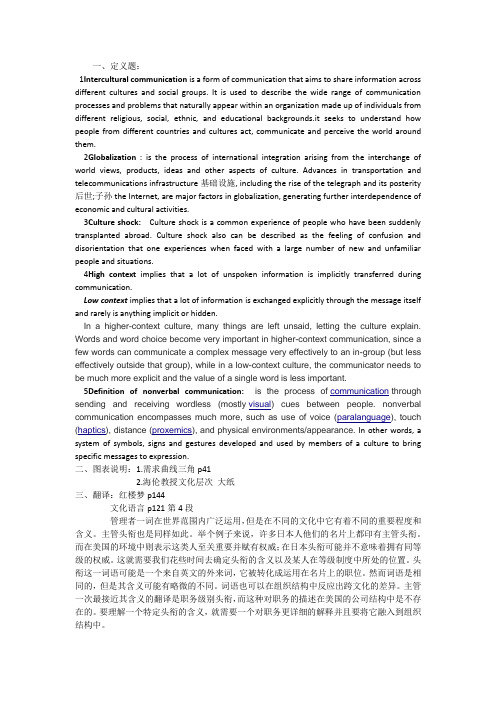
一、定义题:1Intercultural communication is a form of communication that aims to share information across different cultures and social groups. It is used to describe the wide range of communication processes and problems that naturally appear within an organization made up of individuals from different religious, social, ethnic, and educational backgrounds.it seeks to understand how people from different countries and cultures act, communicate and perceive the world around them.2Globalization : is the process of international integration arising from the interchange of world views, products, ideas and other aspects of culture. Advances in transportation and telecommunications infrastructure基础设施, including the rise of the telegraph and its posterity 后世;子孙the Internet, are major factors in globalization, generating further interdependence of economic and cultural activities.3Culture shock: Culture shock is a common experience of people who have been suddenly transplanted abroad. Culture shock also can be described as the feeling of confusion and disorientation that one experiences when faced with a large number of new and unfamiliar people and situations.4High context implies that a lot of unspoken information is implicitly transferred during communication.Low context implies that a lot of information is exchanged explicitly through the message itself and rarely is anything implicit or hidden.In a higher-context culture, many things are left unsaid, letting the culture explain. Words and word choice become very important in higher-context communication, since a few words can communicate a complex message very effectively to an in-group (but less effectively outside that group), while in a low-context culture, the communicator needs to be much more explicit and the value of a single word is less important.5Definition of nonverbal communication:nonverbalsystem of symbols, signs and gestures developed and used by members of a culture to bring specific messages to expression.二、图表说明:1.需求曲线三角p412.海伦教授文化层次大纸三、翻译:红楼梦p144文化语言p121第4段管理者一词在世界范围内广泛运用,但是在不同的文化中它有着不同的重要程度和含义。
跨文化交际课程期末考试资料
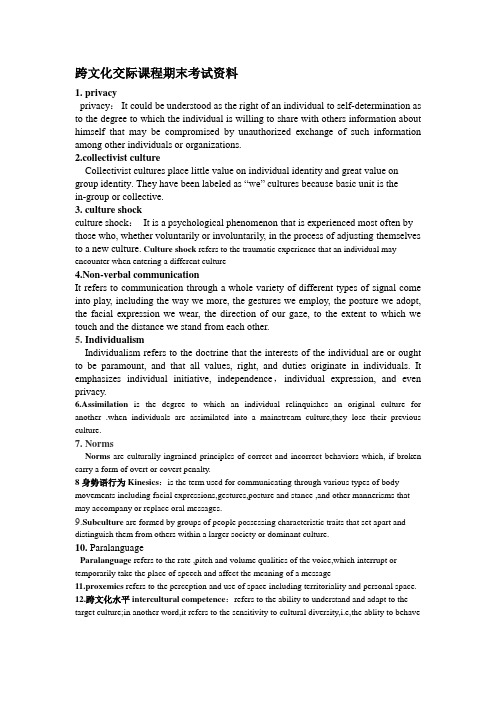
跨文化交际课程期末考试资料1. privacyprivacy:It could be understood as the right of an individual to self-determination as to the degree to which the individual is willing to share with others information about himself that may be compromised by unauthorized exchange of such information among other individuals or organizations.2.collectivist cultureCollectivist cultures place little value on individual identity and great value on group identity. They have been labeled as “we” cultures because basic unit is thein-group or collective.3. culture shockculture shock:It is a psychological phenomenon that is experienced most often by those who, whether voluntarily or involuntarily, in the process of adjusting themselves to a new culture. Culture shock refers to the traumatic experience that an individual may encounter when entering a different culture4.Non-verbal communicationIt refers to communication through a whole variety of different types of signal come into play, including the way we more, the gestures we employ, the posture we adopt, the facial expression we wear, the direction of our gaze, to the extent to which we touch and the distance we stand from each other.5. IndividualismIndividualism refers to the doctrine that the interests of the individual are or ought to be paramount, and that all values, right, and duties originate in individuals. It emphasizes individual initiative, independence,individual expression, and even privacy.6.Assimilation is the degree to which an individual relinquishes an original culture for another .when individuals are assimilated into a mainstream culture,they lose their previous culture.7. NormsNorms are culturally ingrained principles of correct and incorrect behaviors which, if broken carry a form of overt or covert penalty.8身势语行为Kinesics:is the term used for communicating through various types of body movements including facial expressions,gestures,posture and stance ,and other mannerisms that may accompany or replace oral messages.9.Subculture are formed by groups of people possessing characteristic traits that set apart and distinguish them from others within a larger society or dominant culture.10. ParalanguageParalanguage refers to the rate ,pitch and volume qualities of the voice,which interrupt or temporarily take the place of speech and affect the meaning of a message11.proxemics refers to the perception and use of space including territoriality and personal space.12.跨文化水平intercultural competence:refers to the ability to understand and adapt to the target culture;in another word,it refers to the sensitivity to cultural diversity,i.e,the ablity to behavein an appropriate way and to regulate one’s communication and interaction according to the context13.uncertainty avoidance deals with a society’s tolerance for uncertainty and ambiguity ;it ultimately refers to man’s search for truth.是关于一个社会对不确定性和模棱两可的容忍水准。
12-13-02跨文化沟通期末考试复习范围

一.选择题1. When you talk with your friends about Picasso, Beethoven, you are talking about culture from ______ perspective.A. anthropologicB. intellectualC. socialD. psychological2. _____ is the process of putting an idea into a symbol.A. DecodingB. ChannelC. EncodingD. Source3. _____ refers to anything that distorts the message the source encodes.A. NoiseB. MessageC. SourceD. Context4. _____ refers to that portion of the receiver response of which the source hasknowledge and to which the source attends and assigns meaning.A. ReceiverB. DecodingC. EncodingD. Feedback5. Definitions of communication from many Asian countries stress ________,which is most notable in cultures with a Confucian tradition.A. exchanging informationB. harmonyC. respectD. instrumental function6. Communication does not occur in isolation or in a vacuum, but rather it takes placein a physical and a social context; both establish the rules that govern the interaction. Which characteristic of communication does this statement reflect _____?A. SymbolicB. SystematicC. IrreversibleD. Transactional7. The _____ is the person with an idea he or she desires to communicate.A. messageB. sourceC. contextD. feedback8. An American company that operates in Japan almost caused a disaster in theUnited States—Japanese relations by addressing 500 red Christmas cars to its Japanese joint-venture partner, since funeral notices are red in Japan. This case has reflected that each country has its art for _____.A. tippingB. greetingC. card exchangeD. giving gift9. _____ is the environment in which the communication takes place and whichhelps define the communication.A. ContextB. SourceC. Receiver responseD. Feedback10. _____ refers to some words or actions that are avoided by a particular group ofpeople, or in certain culture for religious or social reasons.A. EuphemismB. TabooC. ArgotD. Dialect11. It is quite common in many English speaking countries for ____________.A. students to ignore their professors.B. students to address their professors by the title “Mr”.C. students to ignore any form of address for their professors.D. students to address their professors by their first name.12. Normally, when hearing compliments, a typical Chinese reaction is to show________.A. disagreement and angerB. modesty and humilityC. enjoyment and prideD. pride and gratitude13. In the West, it is regarded polite to open gifts as soon as they are given to express_________.A. greedinessB. understandingC. gratitudeD. Appreciation14. According to intercultural communication theories, collectivism and _________are basic clusters of values and assumptions.A. independenceB. IndividualismC. imbalanceD. communication15. _______ is behaviors such as gestures, body movements, facial expressions, and eye contact.A. ChromaticsB. OlfacticsC. HapticsD. Kinesics16. ________ is the study of how people perceive and use time.A. ProxemicsB. ChronemicsC. KinesicsD. Oculesics17. Communication improvement between cultures requires an ability to ___ .A. speak some of the language and master some non-verbal behaviorB. speak some of the language and master all non-verbal behaviorC. speak the language and master all non-verbal behaviorD. speak the language and master some non-verbal behavior18. It is all right to ask someone what their job or position is, but it’s not polite to askthem their salary. This is considered a ______ matter in English speaking countries.A. humbleB. secretC. privateD. taboo19. Hofstede’s ________ index indicates how much a society feels threatened by ambiguous situations and tries to avoid them by providing rules, believing in absolutetruths, and refusing to tolerate deviance.A. value orientationB. cultural dimensionsC. uncertainty avoidanceD. power distance20. Hofstede’s _____ index measures the extent to which the less powerful membersof organizations and institutions (like the family) accept and expect that power is distributed unequally.A. value orientationB. cultural dimensionsC. cultural valuesD. power distance21. Today, in England, people usually call each other by their first names inA. formal situations outside workB. formal meetings at workC. informal situations outside workD. informal meetings with bosses22. ________ style focuses on the speaker and personal relationships. Such style canbe found in individualistic and low-context culture.A. ContextualB. PersonalC. SuccinctD. Elaborate23. Li Ming, a Chinese student, had lived several years in the United States. A monthago, he came back to China and found everything was unfamiliar and weird.Liming is in_____ stage of intercultural adaptation.A. honeymoon phaseB. adjustment periodC. reentry shockD. crisis period24. Mr. Wang, a Chinese immigrant in U.S, has adapted himself so well to Americanculture that he gradually lost his Chinese cultural identity. This process is called ___________.A. separation and segregationB. integrationC. assimilationD. marginalization25. _______ takes place when individuals become an integral part of the new culturewhile maintaining their cultural integrity.A. Culture shockB. AcculturationC. Cultural identityD. Integration26. The dialogues at the United Nations, for example, would be termed _________.A.interracial communicationB. interethnic communicationC.international communicationD. interpersonal communication27. In China, if a Tibetan communicates with a Han, it is _____.A. interracial communicationB. interethnic communicationC.internationalcommunicationD. interpersonal communication28. _____ refers to the exchange of messages between members of the dominantculture within a country.A. Interethnic CommunicationB. Intercultural CommunicationC. international CommunicationD. Interregional Communication29._____ occurs when the sender and the receiver exchanging messages are fromdifferent races with different physical characteristics.A. Interethnic CommunicationB. Interracial CommunicationC. Intracultural communicationD. Intercultural communication30. _____ refers to one’s sense of belonging to a particular culture or ethnic group.A. Cultural identityB. Cultural valueC. Cultural normD. Subculture31. Mr. Wang, a Chinese immigrant in U.S, has adapted himself so well to Americanculture that he gradually lost his Chinese cultural identity. This process is called_____.A. separation and segregationB. integrationC. assimilationD. marginalization32. Liming, a Chinese student, just began his study in a university in the United States.In his first week in U.S, he thought everything was new and exciting, and he enjoyed himself a lot. Liming is in_____ stage of culture shock.A. honeymoonB. crisisC. reintegrationD. gradual adjustment33. _____ refers to maintaining one’s original culture a nd not participating in thenew culture.A. Separation and segregationB. AssimilationC. MarginalizationD. Integration34. _____ refers to an individual’s learning and adopting the norms and values ofthe new host culture.A. AcculturationB. DeculturationC. MarginalizationD. Assimilation35. _____ takes place when individuals become an integral part of the new culturewhile maintaining their cultural integrity.A. Culture shockB. IntegrationC. Cultural identityD. Acculturation36. In______, the handshake is accompanied with a light kiss; even males kiss bothcheeks after a handshake.A. the United StatesB. Saudi ArabiaC. RussiaD. France37. _____ style focuses on the speaker and role relationships. People with suchcommunication style stress high power distance. This style is popular in collectivist and high-context culture.A. ContextualB. PersonalC. SuccinctD. Elaborate38. _____ refers to some words or actions that are avoided by a particular group ofpeople, or in certain culture for religious or social reasons.A. EuphemismB. TabooC. ArgotD. Dialect39. The _________ refers to the ability to understand and adapt to the target culture;in another word, it refers to the sensitivity to cultural diversity, i.e., the ability to behave in an appropriate way and to regulate one’s comm unication and interaction according to the context.A. intercultural competenceB. social competenceC. communication competenceD. cultural competence40. _________ refers to losing one’s cultural ide ntity and not having anypsychological contact with the larger society.A. MarginalizationB. AcculturationC. Culture shockD. Separation and segregation41. _________ refers to the traumatic experience that an individual may encounterwhen entering a different society.A. DissimilationB. AssimilationC. IntegrationD. Culture shock42. _____ is behaviors such as gestures, body movements, facial expressions, and eyecontact.A.ChromaticsB.OlfacticsC. HapticsD. Kinesics43. While writing business messages, ______is usually the first step.A. predictionB. selectionC. analysisD. planning44. While the highest goal of communication in the Eastern Culture is to achieve ___,the highest goal of communication in the West is to achieve the practical cooperation from others.A. proprietyB. further relationshipC. practical purposeD. definite result45. _____ is the study of communications sent by the eyes.A. OculesicsB. HapticsC. KinesicsD. Chromatics46. Which of the following statements about intercultural communication is not true?A. It is communication between people of different cultures.B. We need understanding and acceptance in intercultural communication.C. During the process of intercultural communication, one should turn one’s backon one’s own culture.D. We should develop tolerance and acceptance in intercultural communication.47. _____ is the study of how people perceive and use time.A. ChronemicsB. ProxemicsC. KinesicsD. Oculesics48. _____is the traditional way of greeting in Northeast Asian countries like Koreaand Japan.A. BowingB. Firm handshakeC. EmbracingD. Handshake49. _____ means the act of substituting a mild, indirect, or vague term for oneconsidered harsh, blunt, or offensive.A. EuphemismB. TabooC. ArgotD. Dialect50. _____ style focuses on the speaker and personal relationships. Such style can befound in individualistic and low-context culture.A. ContextualB. PersonalC. SuccinctD. Elaborate51. ______ refer to rules for appropriate behavior, which provide the expectationspeople have of one another and of others.A. BeliefsB. ValuesC. RolesD. Norms52. _____ refers to intentional use of nonspoken symbol to communicate a specificmessage.A. ProxemicsB. ChronemicsC. Nonverbal communicationD. Olfactics53. _____is considered inappropriate as a form of greeting in the United States andmodern China.A. EtiquetteB. BowingC. EmbracingD. Handshake54. In the _____ culture, the interest of the individual prevails over the interests of thegroup.A. masculinityB. femininityC. individualistD. collectivism55. ______ is assuming that a person has certain qualities (good or bad) just becausethe person is a member of a specific group.A. RacismB. PrejudiceC. SexismD. Stereotyping56. In the United States, the main meal is ______.A. in the morningB. at noonC. in the eveningD. B or C57. _______ refers to attaching meaning to sense data and is synonymous withdecoding.A. PerceptionB. InterpretationC. SensationD. Selection二.判断题的范围:1-7单元课后的判断题三.简答题1. What are the characteristics of culture?2. What is the nature of culture?3. What are the characteristics of communication?4. What are the components of communication?5. What are the barriers to effective intercultural communication?6. What are the categories of nonverbal communication?7. What are the four modes of acculturation?8. What are the four stages of the U-curve pattern intercultural adaptation?9. How is sex different from gender?10. How to distinguish high context culture from low context culture?11. What are the forms of culture shock?12. What are the components of cultural patterns?13. What are the differences between Chinese and English compliments?14. What are the differences between direct and indirect verbal communication styles?15. What does the power distance measure according to Hofstede?四.案例分析重点考察内容:verbal communication; nonverbal communication; communication styles。
2005-2006学年秋季学期跨文化交际导论期末试题(A卷)
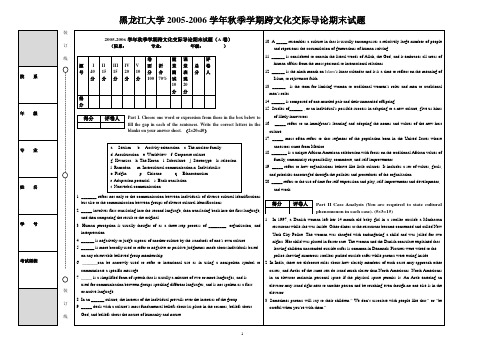
装
or native language.
elevator may stand right next to another person and be touching even though no one else is in the elevator.
8. In an ______ culture, the interest of the individual prevails over the interests of the group. 订
3. Human perception is usually thought of as a three-step process of ________, organization, and
restaurant while she was inside. Other diners at the restaurant became concerned and called New
l. Ramadan m. Intercultural communication n. Individualist
o. Pidgin
p. Chicano
q. Ethnocentrism
r. Adaptation potential s. Back translation
t. Nonverbal communication
院系 年级 专业 姓名 学号 考试课程
黑龙江大学 2005-2006 学年秋季学期跨文化交际导论期末试题
装
2005-2006 学年秋季学期跨文化交际导论期末试题(A 卷)
10. A _____ resembles a culture in that it usually encompasses a relatively large number of people
2005-2006学年春季学期大学英语跨文化交际课程期末试题...
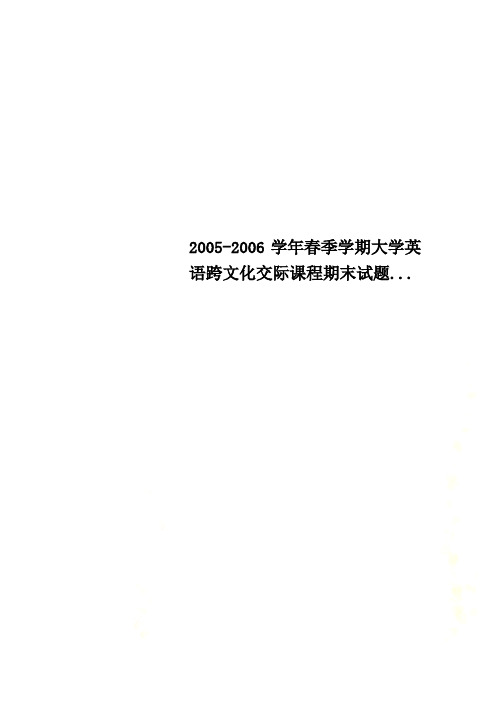
(院系:
专业:
订
级:
)
年 11.
deals with a society’s tolerance for
uncertainty and ambiguity; it ultimately refers
to man’s search for Truth.
12. ________refers to manners and behaviors
silent contempt.” The Allies took it as the most
线
offensive meaning.
.
1.
refers to that portion of the receiver
response of which the source has knowledge
2005-2006 学年春季学期大学英 语跨文化交际课程期末试题...
黑龙江大学 2005-2006 学年春季学期大学英语跨文化交际课程期末试题
装
10. In the
culture, the interest of the
2005-2006 学年春季学期大学英语跨文化交际课程期末试题(A 卷)
individual prevails over the interests of the group.
专业
得
17. Confucius encouraged a sense of __________and harmony.
分
18.The
refer to the ability to understand
and adapt the target culture; in another word, it
Intercultural Communication中国大学mooc课后章节答案期末考试题库
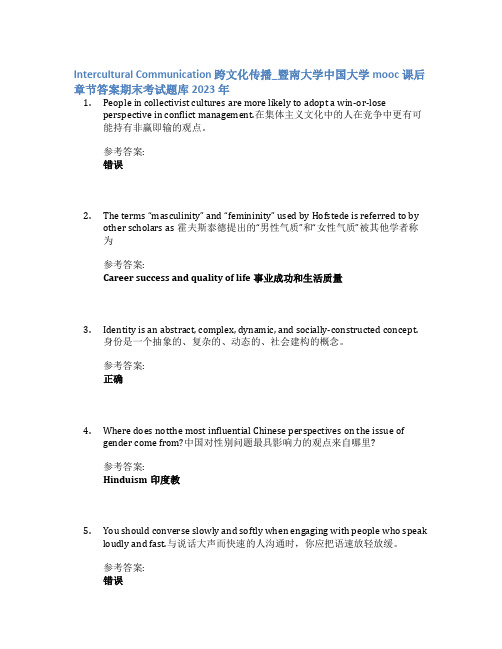
Intercultural Communication 跨文化传播_暨南大学中国大学mooc课后章节答案期末考试题库2023年1.People in collectivist cultures are more likely to adopt a win-or-loseperspective in conflict management.在集体主义文化中的人在竞争中更有可能持有非赢即输的观点。
参考答案:错误2.The terms “masculinity” and “femininity” used by Hofstede is referred to byother scholars as霍夫斯泰德提出的“男性气质”和“女性气质”被其他学者称为参考答案:Career success and quality of life事业成功和生活质量3.Identity is an abstract, complex, dynamic, and socially-constructed concept.身份是一个抽象的、复杂的、动态的、社会建构的概念。
参考答案:正确4.Where does notthe most influential Chinese perspectives on the issue ofgender come from?中国对性别问题最具影响力的观点来自哪里?参考答案:Hinduism印度教5.You should converse slowly and softly when engaging with people who speakloudly and fast.与说话大声而快速的人沟通时,你应把语速放轻放缓。
参考答案:错误6.The cultural specific approach is superior to the cultural general approachbecause there is no universal traits and influences that can be transferred from culture to culture.坚持文化特殊性的方法优于文化一般性的方法,因为没有可以从一种文化转移到另一种文化的普遍特征和影响。
跨文化交际_北京联合大学中国大学mooc课后章节答案期末考试题库2023年
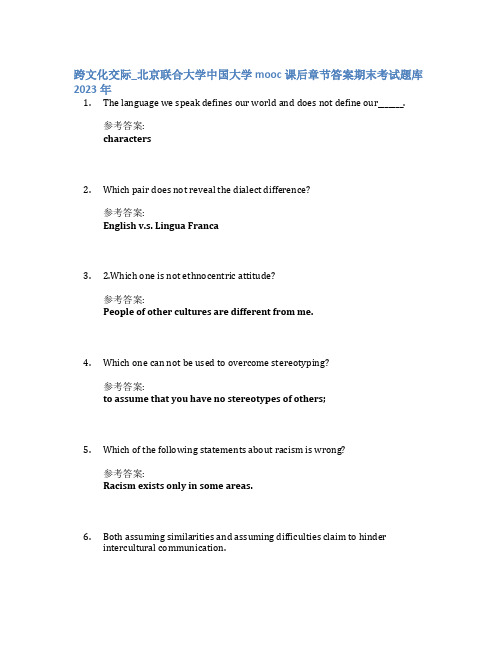
跨文化交际_北京联合大学中国大学mooc课后章节答案期末考试题库2023年1.The language we speak defines our world and does not define our_______.参考答案:characters2.Which pair does not reveal the dialect difference?参考答案:English v.s. Lingua Franca3. 2.Which one is not ethnocentric attitude?参考答案:People of other cultures are different from me.4.Which one can not be used to overcome stereotyping?参考答案:to assume that you have no stereotypes of others;5.Which of the following statements about racism is wrong?参考答案:Racism exists only in some areas.6.Both assuming similarities and assuming difficulties claim to hinderintercultural communication.参考答案:正确munication occurs whenever meaning is attributed to behavior or theresidue of behavior.参考答案:正确8.Nonverbal symbols are visible and obvious to an outside observer. They aredetermined by values, which are the deeper manifestations of culture and the most difficult to understand by an outsider.参考答案:正确9.Rituals are those collective activities that are considered socially essentialwithin a culture such as sports events.参考答案:正确10.Culture is so small and inclusive that it is really easy to define.参考答案:错误11.The simplest definition of culture is a set of ________ within a group or societyand institutional learned behavior.参考答案:values and norms12.Cultural patterns can be interpreted from two aspects consisting of ways of____________.参考答案:thinking and acting13.Culture is “the arts and other manifestations of human intellectualachie vement regarded collectively.”参考答案:正确14.Which statement is true?参考答案:People from different cultural backgrounds will have a unique way of doing things, analyzing situations and reacting to circumstances.15. A pidgin is ________.参考答案:a language which has no native speakers16.The message sent without using words are called _________ communication.参考答案:nonverbal17.The functions of nonverbal communicationdoesn’tinclude _______________.参考答案:monitoring18.Which of the following doesn’t belong to the category of paralanguage?参考答案:smile19.The social zoneranges from ________________.参考答案:1.22 – 3.6 meters20.People from________are said to belong to polychronic people.参考答案:India21.Stereotypes are always negative which may evoke conflicts in interculturalcommunication events.参考答案:错误22.If we don’t know the fact that the same word means differently in differentcontexts, communications will be hindered.参考答案:正确23._______ are said to belong to the high-touch cultures.参考答案:The Italians24.__________ deals with the innate character of human nature.参考答案:The human nature orientation25.Hall suggests that the only way to learn the internal culture of others is toactively ________ their culture.参考答案:participate in26.The phrase “go Dutch” means __________________.参考答案:splitting the cost27.China and Japan belong to low-context culture; while America and Germanbelong to high-context culture.参考答案:错误28.In order to be successful in intercultural communication, people should learnonly cultural differences.参考答案:错误29.Cross-cultural communication emphasizes the differences of differentcultural communities or groups.参考答案:正确30._____________ together constitute the components of cultural patterns.参考答案:Beliefs, values, norms and social practices31.International communication takes place between nations and countriesrather than individuals.参考答案:正确32.In intracultural communication, speakers rely on their prior knowledgerooted in cultural models, core common ground, shared knowledge, common beliefs of a relatively definable speech community.参考答案:正确33.We usually take culture for granted since everything we see and do takesplace in different culture.参考答案:错误34. A message refers to any signals that trigger the response of a receiver.参考答案:正确35.There are at least 6 key components of communication: sender, message,channel, receiver, noise and feedback.参考答案:正确36.We communicate with others for the sheer pleasure of interaction. This is itspractical function.参考答案:错误37.Western cultures emphasize the harmony between the communicators.参考答案:错误38. 1. Which of the following statement is not true?参考答案:A verbal code comprises a set of rules governing the use of words increating a message, along with the words themselves.39.To show number two, a person from ______will hold up histhumb and indexfinger.参考答案:France40.People from __________are taught to avoid eye contact with elders, teachers,and other people with status as a sign of respect.参考答案:Latin America41.Which culture are indirect styles more likely to be used in?参考答案:Chinese and Japanese cultures42. 1.What strategies does the Uncertainty Reduction Theory involve?参考答案:above all.43.Which response reflects self-enhancement? --I love your sweater. You look sosmart in it.参考答案:--I know. I just bought it yesterday.44.In which culture people do not use metaphorical expressions in every dayconversation.参考答案:American culture45.Which statement is not right?参考答案:In high-context culture, meaning is conveyed through verbal codes.。
跨文化英语Answersto期末复习题
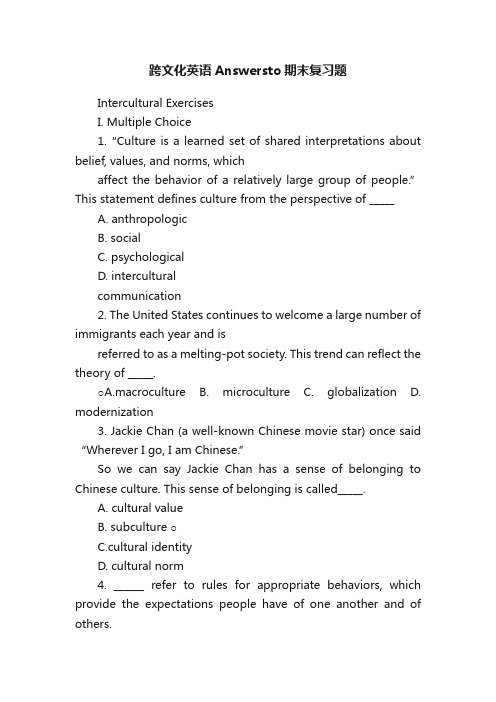
跨文化英语Answersto期末复习题Intercultural ExercisesI. Multiple Choice1.“Culture is a learned set of shared interpretations about belief, values, and norms, whichaffect the behavior of a relatively large group of people.” This statement defines culture from the perspective of _____A. anthropologicB. socialC. psychologicalD. interculturalcommunication2. The United States continues to welcome a large number of immigrants each year and isreferred to as a melting-pot society. This trend can reflect the theory of _____.○A.macroculture B. microculture C. globalization D. modernization3. Jackie Chan (a well-known Chinese movie star) once said “Wherever I go, I am Chinese.”So we can say Jackie Chan has a sense of belonging to Chinese culture. This sense of belonging is called_____.A. cultural valueB. subculture ○C.cultural identityD. cultural norm4. ______ refer to rules for appropriate behaviors, which provide the expectations people have of one another and of others.A. BeliefsB. ValuesC. RolesD. Norms5. Mr. Wang, a Chinese immigrate in the U.S, has adapted himself so well to Americanculture that he gradually lost his Chinese cultural identity. This process is called_____.A. separation and segregationB. integration ○C.assimilationD. marginalization6. _____ is the process of putting an idea into a symbol.A. DecodingB. ChannelC. EncodingD. Source7. In China, if a Tibetan communicates with a Han, it is _____.A. interracial communicationB. interethnic communicationC. international communicationD. interpersonal communication8. There is a Chinese belief that “One is good in nature with different characteristics butsimilar habits. However, if he is not well educated, his nature changes ”. This belief can reflect that_____.A. Human nature is evil but perfectible.B. Human nature is a mixture of good and evil.C. Human nature is good but corruptible.D. None of the above.9. _____ deals with a culture’s most fundamental beliefs about its place in the cosmos, beliefs about God, and beliefs about the nature of humanity and nature.○A. Worldview B. Life view C. V alue D. Cultural value10. Cultures, such as China and Japan, belong to _____ cultures.A. silent ○B. high-contextC. low-context D perception11. Which one is not the reason for the persistence of ethnocentrism, stereotypes, prejudice and racism? ______A. SocializationB. Social benefitC. Economic benefit ○D.Industrialization12. Dragon, the symbol of evil, is a dinosaur-like animal in western culture, usually the keeper of treasure or princess. Chinese dragons are so different from western ones. They are the God of rain and symbol of emperor. This reflects words ______.A. with counterpart in another languageB. without counterpart in another languageC. with same associated meaningsD. with different associated meanings13. _____ style values low amount of talk, or even silence. This style can be found in high-context culture with high uncertainty avoidance.A. ElaborateB. Exacting ○C. SuccinctD. Contextual14. Chinese idioms “祸从口出”(Disaster emanates from careless talk.)and”沉默是金”(Silence is gold.)express ______ communication style.A. elaborateB. succinctC. exactingD. contextual15. Which is the following NOT the major religion in the world?A. ChristianityB. IslamC. ConfucianismD. Buddhism16. _____ is the way we use fixed space and personal space.A. Olfactics ○B. ProxemicsC. HapticsD. Kinesics17. 4 feet to 12 feet, the distance between salespeople and customers and between peoplewho work together, is called _______ zone.A. intimateB. personalC. socialD. public18. __________ is interaction that is perceived as effective in fulfilling certain rewardingobjectives in a way that is also appropriate to the context in which the interaction occurs.A. Intercultural competence ○B. Competent communicationC. Social competenceD. Communication competence19. ______ promote a correct perception of the host environment and its social systems.A. Social s kills ○B.Cognitive skillsC. Linguistic skillsD. IT skills20. In the _____ culture, the interest of the individual prevails over the interests of thegroup.A. masculinityB. femininityC. individualistD. collectivismII. Check the following statements True or False (基数题为T)21.Norms refer to rules for appropriate behaviors, which provide the expectations peoplehave of one another and of others.22.Encoding is the activity during which the receiver attaches meaning to the wordsor symbols he/she has received.23. Subculture/Co-culture exist within dominant cultures and are often based on economic or social class, ethnicity, race, or geographic region.24. Ethnocentrism emphasizes that other cultures are better than it own culture.25.The similarity of the original culture to the new host culture is one of the mostimportant factors in successful acculturation.26. Westerners believe that one is good in nature with different characteristics but similarhabits.27. In Arabi c, the camel plays significant roles in people’s life, so there are morethan 40 words for “camel”.28. Different from the belief “subjugation to nature”, western people believe they are themasters of the nature.29. All words can find the counterparts(对译词)in another language.30. Individualism emphasizes that one’s personal goals take priority over theirgroups like the family or the employerIII. Case Analysis31. Wang Lei, a Chinese student, knows every word in the following sentence “Theold man kicked the bucket”, but he is confused about this sentence since it means that the old man died.32.Mr. Bias is a director of a European private company. Now he is interviewing candidatesfor the position of assistant manager. He selected a bright and ambitious applicant. Later, he discovered that this applicant was from the country India. Since he thinks that all Indians are stupid and lazy, he has decided to select someone else for the position. (Answer for reference:This case reflects one of the barriers of intercultural communication---- prejudice. Prejudice refers to the irrational dislike, suspicion, or hatred of a particular group, race, religion,or sexual orientation. Prejudice involves an unfair, biased, or intolerant attitude towards another group of people. The attitude of the boss just had the prejudice towards the applicant. )33. In intercultural business negotiation settings, American negotiators are mission-driven,and they express their offers openly. They may say “Let’s go to the point”. While C hinese negotiators usually look forward to long-term partnership. There is a slow start to “warm up”, they don’t expect any open conflict for whatever reasons, and they are always trying to “save face” for both sides.(Answer for reference:This case can reflect the differences between direct and indirect communication styles. Withdirect communication style, speaker expresses his intention openly and directly. Direct styles are often used in low-context, individualistic cultures. In an indirect communication style, which is often seen in high-context and collectivistic cultures, speakers usually hide or hint their intentions during interaction. So the American negotiators and Chinese negotiators will express their offers differently according to the different communication style. )33. In Asia, white hair earns respect. In a delegation of three people, one of whom has whitehair, that one will be first to be seated, first to be greeted, first through doors, and so forth.(Answer for reference:This case has reflected that cultural differences exist concerning the status of age and hierarchy in some societies. In such societies people are very aware of age and hierarchy. Age is viewed as an indication of seniority. People have a great respect for age in such countries. This case shows us that in Asia whereolder members of organizations enjoy great freedom and power and one only becomes high ranking with age. )IV. Short Answer34. How important is non-verbal communication? What are some ways of non-verbalcommunication?35. What are the differences between Chinese culture and western culture?36. How is culture learned? What are the ways of improving your interculturalcommunication competence?V . English-Chinese Translation37. Staring at people or holding a glance too long is considered improper in English-speaking countries. Even when the look may be one of appreciation---as of beauty---it may make people uneasy and embarrassed. Many English-speaking people in China have complained about this. A lady decided to leave China, with some reluctance(恋恋不舍); however, she still left before she had planned to.38. Acculturation(文化适应)refers to an individual’s learning and adopting the norms and values of the new host culture. It includes four modes as Assimilation, Integration, Separation / Segregation and Marginalization.。
大学英语跨文化交际 - 副本
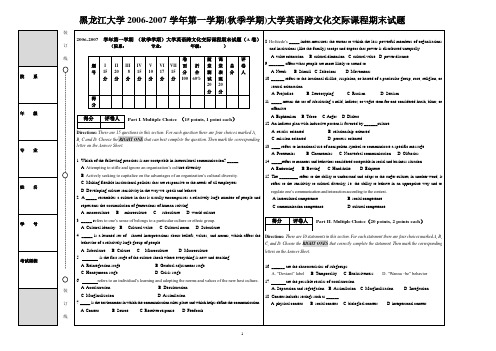
A. EuphemismB. Taboo C. Argot D. Dialect
8.Hofstede’s_____index measures the extent to which the less powerful members of organizations and institutions (like the family) accept and expect that power is distributed unequally.
10.______ refers to the irrational dislike, suspicion, or hatred of a particular group, race, religion, or sexual orientation.
A. Prejudice B. Stereotyping C. Racism D. Sexism
D.Developing culture sensitivity in the way we speak and behave.
2. A _____ resembles a culture in that it usually encompasses a relatively large number of people and represents the accumulation of generations of human striving.
7._____ is the environment in which the communication takes place and which helps define the communication.
大学英语跨文化交际双语课程水平测试题(四)

大学英语跨文化交际双语课程水平测试题(四)I. Multiple Choice (20 points, 2 points each)Directions: There are some statements in this section. For each statement there are four choices marked A, B, C, D, choose the ONE that best complete the statement.1.______ refers to hostile words and/or actions that people say or do against a certain groupbecause that group is different.A. Hate speechB. Betrayal speechC. Patriotic speechD. Academic Speech2._____ style focuses on the speaker and role relationships. People with such communicationstyle stress high power distance. This style is popular in collectivist and high-context culture.A. ContextualB. PersonalC. SuccinctD. Elaborate3._____ refers to some words or actions that are avoided by a particular group of people, or incertain culture for religious or social reasons.A. EuphemismB. TabooC. ArgotD. Dialect4.The _________ refers to the ability to understand and adapt to the target culture; in anotherword, it refers to the sensitivity to cultural diversity, i.e., the ability to behave in an appropriate way and to regulate one’s communication and interaction according to the context.A. intercultural competenceB. social competenceC. communication competenceD. cultural competence5.__________ stresses that it is important that others’ behavior is no longer evaluated as goodor bad, as viewed through the filtering cultural lenses, but that people have different approaches to different people.A. EthnocentrismB. EthnologyC. EthnorelativityD. Ethnopsychology6._________ takes place when individuals become an integral part of the new culture whilemaintaining their cultural integrity.A. Culture shockB. IntegrationC. Cultural identityD. Acculturation7._________ refers to losing one’s cultural identity and not having any psychological contactwith the larger society.A. MarginalizationB. AcculturationC. Culture shockD. Separation and segregation8._________ refers to the traumatic experience that an individual may encounter whenentering a different society.A. DissimilationB. AssimilationC. IntegrationD. Culture shock9.__________ refers to the specific behaviors through which individuals’ capacity to expresscognitive and affective experiences outwardly is shown.A. The cognitive competenceB. The motive competenceC. The behavioral competenceD. The affective competence10._____ is behaviors such as gestures, body movements, facial expressions, and eye contact.A. ChromaticsB. OlfacticsC. HapticsD. KinesicsII. Terms (15 points, 3 points each)Directions: There are five terms in this section. Try to explain the following terms in your own words. Then write down the answers on the Answer Sheet.11.Culture Merge12.Chronemics13.Proxemicspetent Communication15.ConfucianismIII. Case Analysis (20 points, 5 points each)Directions: In this section you are supposed to analyze the following cases from the perspective of intercultural communication. Then write down the answers on the Answer Sheet.16.In 1979, the Shah of Iran was admitted to the United States for medical reasons. TheIranians reacted by holding all the diplomatic personnel hostage in the embassy in Iran. The secretary of state was Henry Kissinger, and the president was Jimmy Carter. The United States took the position that the Iranians should not be upset with the Shah being allowed into the United States for the humanitarian reason of medical need. The Shah had been a friend to the United States and the United States to the Shah; therefore, the U.S government felt a certain obligation to Shah. The revolution in Iran was based on Islamic religious assumptions.17.A U.S. American woman executive is sent to negotiate a contract with a corporation in SaudiArabia. She dresses conservatively in a dark business suit and completes her makeup and hair as she would in the United States. She finds the Arabs to be very aloof. She is asked when her boss will be arriving and is basically feeling ignored.18.A group of high-powered businessmen from New York arrived in Mexico City to give apresentation. They had timed detailed agendas; a long contract; and specific plans for a joint venture. They distributed the materials, said they were pressed for time, and needed to complete the meeting so they could catch their plane. The Mexicans sat very quietly during the presentation. After the presentation, the New Yorkers on their way home congratulated themselves on their success. The Mexicans, however, felt they would not be able to work with these New Yorkers.19.Ching Lee was transferred by his Asian firm to assume a managerial position in a largeautomobile production plant in the United States. In his first report to his supervisor, he expressed concern that U.S workers were not giving him the proper respect.IV. Answer the following questions. (30 points, 5 points each)Directions: In this section you are supposed to answer the following questions with the knowledge of intercultural communication. Then write down the answers on the Answer Sheet.20.What are the characteristics of subgroups?21.What are the possible reasons for culture shock?22.What do you think that “communication is irreversible”?23.What are reasons for the persistence of ethnocentrism, stereotypes, prejudice and racism?24.What are the requirements for intercultural competence concerning language?25.What are the functions of nonverbal communication?V. English —— Chinese Translation (30 points, 3 points each)Directions: In this section you are supposed to translate the underlined sentences into Chinese. Then write down the answers on the Answer Sheet.In China it is relatively usual to ask people their age, but in the West this question is generally regarded as impolite. 26. This is particularly true of women, and even more so if the inquirer is a man.27. However , it is very normal to ask children their age , and some adults may not mind being asked either. 28. In fact , some elderly people are quite happy to reveal their age, especially if they feel they look young for their age. Nevertheless, it is not very wise to ask a direct question like ‘How old are you? ’ If elderly people want to talk about their age , and perhaps receive a compliment on how young they look, they may easily bring up the topic themselves, and ask the other person to guess how old they are. In such a situation, it is quite acceptable to discuss age freely. 29. They normally expect to be complimented on their youthfulness, though , rather than to be told that they look very old.Even though Westerners do not usually ask people direct how old they are, this does notmean that they are not interested to know how old other people are. They may ask someone else for the information, or else they may try to approach the topic indirectly. 30. Sometimes discussion about educational background and the years of working experience may provide some clues, but this is not always the case.。
英语跨文化交际参考题

英语跨⽂化交际参考题考⽣姓名:____________ 学号:___________ 专业班级:注意:1. 试卷、答题纸上按要求写上姓名、学号和专业班级。
2.所有题⽬答案必须写在答题纸上,做在试卷上⼀律⽆效。
3.考试结束,试卷全部回收,不准带出考场。
Part I. Multiple ChoiceDirections:There is one blank in each sentence. For each blank there are four choices marked A, B, C, and D. You should choose the ONE that best fits into the blank, and write down your answer on the Answer Sheet.1. Who is the father of intercultural communication study?A. Edward T. HallB. Marshall McLuhanC. Gudykunst, W.B.D. Chomsky2.Which is not the major purpose of learning ICC?A.Develop understanding of culture to appreciate opportunities and challenges.B. Learn as many languages as possible.C. Expand communication skills and ability to be appropriate to various settings.D. Forge an intercultural vision to deal with culture shock.3. Any change in the subsystem of culture will affect the whole system indicates .A. Culture is holistic.B. Culture is shared.C. Culture is created.D. None of them4. In orientation work is considered a separate activity from play.A. doingB. becomingC. beingD. all of them5. Which of the following examples can not elicit difference in social relation orientation?A. In America, professors are called by their first names, instead of the last names inChina.B. In some European countries, the family into which a person is born determine his social position, while, in America, rags-to-riches stories are popular.C. Extended families are popular in China,while nuclear families are popular in America.D. American believes the universe can be controlled, while, Chinese believe in theunity of man and nature.6. Phrases like “make time”, “save time” and “gain time” indicate people’s time orientation.A. past-oriented B present- oriented C. future-oriented D. none of them7. Time is viewed endless and ongoing in .A. European AmericansB. Indians and African AmericansC. European Americans and Latin AmericansD. All of above8. Which proverb can not indicate individualism?A. The squeaky wheel gets the grease.B. God help those who help themselves.C. Out of mouth comes evil.D. Every man is the architect of his own fortune.9. Among all the physical environment elements, which belong(s) to natural environment?A. geography and climateB. city architecture and city environmentC. city design and house designD. room design and decoration10. Hegel said, “When man feels he is limitless at the sea, he will have great courage to surpass the limit.” This quotation indicates .A. unity of man and natureB. social relation orientationC. world viewD. future-oriented time orientation11. Which of the following choices can not show concept of personal space?A. People is supposed to ask for permission to sit down on a half-occupied bench in a park.B. It is impolite to shoulder your way when you are waiting in the train station.C. Such questions li ke “Have you had your meal?” are very common in China whenpeople meet in the street.D. In public spaces, “temporary territory” is highly valued.12. are of special significance among ten components of communication?A. Source and receiverB. Noise and channelC. Encoding and decodingD. Context and feedback13. Having dinner in a romantic restaurant and in an isolated island will influence participants’ speaking style shows communication is different inA. physical contextB. social context C interpersonal context D all of above14. Which of the following choices is not a feature of western thinking pattern?A. analysisB. factual reasoning C logic D. holistic15. Which of the following sentence does not indicate eastern pattern of thinking?A There are both advantages and disadvantages in country life.B. Every coin has two sides.C. People value the wisdom of being foolish in daily life.D. People make sense of the daily life by objectivity and specificity.16. Which kind of communication apprehension is considered enduring and hard to be overcame?A. trait like B context-based C. audience-based D. situation-based17. Irish people lost their language (Celtic) is an example ofA. combinationB. migrationC. assimilationD. acculturation18. Which of the following statements is (are) positive implication(s) of culture shock?A. mood of mania and excitementB. emotional richness and enhanced toleranceC. personal retrogressD. psychosomatic problems19. In which period does the sojourner (旅居者) may appreciate the new culture of host country?A. adjustment periodB. reentry periodC. frustration periodD. honeymoon period20. In order to achieve intercultural communication competence, one should not .A. pay more attention to the contextB. expand knowledge of distinctive culture orientationC. understand how people think and behave in host cultureD. abandon and criticize the original culture and get yourself assimilated in hostculturePart II. Blank FillingDirections: In this part, there is a blank in each sentence. You are required to select one word or one phrase that best fits into the blank from a list of words in the following table. Write your answers on the Answer Sheet.1. __________ is the process by which a message is converted into an idea by the receiver.2. __________ is a cultural orientation where meanings are gleaned from the physical, social, and psychological contexts.3. __________ is an arbitrarily selected and learned stimulus representing something else.4. __________ is a cultural orientation where the individual is unique and that emphasizes individual goals over group goals.5. ___________ is a systematic set of sounds, combined with a set of rules, for the purpose of communicating.6. ___________ is the effects associated with the tension and anxiety of entering a new culture, combined with the sensations of loss, confusion, and powerlessness resulting from the forfeiture of cultural norms and social rituals.7. ____________ is the degree to which a communication message has many possible meanings to its receivers.8. ___________ is the total combination of one’s group roles. A part of individual’s self-concept that is derived from the person’s membership in groups.9. ____________ is the recognition that several different cultures can exist in the same environment and benefit each other.10. ___________ is an individual who visits another culture for a period of time but who retains his/her original culture. Part III. Matching WordsDirections:Choose the words from the right side that best explain the meanings of the words on the left side. Write your answers on the Answer Sheet.1. mediation A) an emotional response to objects, ideas, and people2. context B) a message that is sent back by the receiver to the source3. source C) the degree to which a person is open to others’ point of view4. perception D) anything that interferes with the communication process5. feedback E) the encoding and decoding process during communication6. dynamic F) process of finding peaceful solutions to a conflict7. pluralism G) people who originate a communication by encoding an idea8. attitude H) the mental interpretation of external stimuli via sensation9. transactional I)something that is considered active and forceful10. noise J) cultural circumstances within which communication occursPart IV. Short Answer QuestionsDirections:In this part, you are supposed to answer the following question with the knowledge of intercultural communication. Write down your answers on your Answer Sheet.Topic: Discuss briefly the characteristics of monochronic and polychronic time orientation. Part V. Case Analysis Directions:In this part you are supposed to analyze the following case from the perspective of intercultural communication. Then write down the answers on the Answer Sheet.CaseTom, an exchange student from England, is talking with Mary, his girlfriend from Australia in Tom’s dorm room about their holidays. At this time, Yahan, an exchange student from India, enters in the room unannounced.Tom: (to Mary) So, I think we should spend a week in China, 4 days in Japan. It is fantastic to know the East.(Yahan enters.)Yahan: Hello Tom. Who is this with you?Tom: Oh, hi Yahan. This is Mary. Mary, this is Yahan; he lives just down the hall. Mary:Hi Yahan.Yahan:Is this your girlfriend, Tom?Tom:Ah…yeah, she is.Yahan: Are you two going to marry? Want children?Tom:Ah, well….Mary:Uh…we really haven’t discussed that yet.Yahan: Oh, I see. Is your family not wealthy enough for her, Tom? What is your father’s occupation?Tom:What?Part VI.Essay QuestionsDirections: In this part, there are 2 essay topics. You are supposed to choose one from themto write an essay with at least 150 words.1. Use examples to explain the main characteristics of individualism and collectivism.2. Describe the differences of verbal communication styles between Chinese people and American people, and then analyze the reasons of the differences.。
期末英语专业跨文化交际试题试题及参考答案

期末英语专业跨文化交际试题试题及参考答案一、阅读理解(共30分)阅读下面短文,并根据文章内容选择正确答案。
Passage 1Communication styles and norms differ significantly between cultures, and understanding these differences is essential for successful cross-cultural communication.In some cultures, such as the United States and Canada, direct communication is highly valued. People tend to speak their mind openly and directly, even if it means disagreeing with others. They believe in being straightforward and assertive.On the other hand, in many Asian cultures, such as Japan and China, indirect communication is the norm. People are more likely to hint at what they mean rather than stating it outright. They often use nonverbal cues and context to convey their messages. This communication style values harmony and maintaining face.When engaging in cross-cultural communication, it is important to be aware of these differences and adjust your communication style accordingly. If you are from a direct communication culture, you may need to be more sensitive to nonverbal cues when interacting with individuals from an indirect communication culture.1. According to the passage, direct communication is highly valued in which cultures?A. Asian culturesB. United States and CanadaC. European culturesD. African cultures2. What is the communication style in Japan and China?A. Direct communicationB. Indirect communicationC. Nonverbal communicationD. Contextual communication参考答案:1. B2. B二、交际用语(共10分)根据对话情境和所给选项,选择恰当的答案完成对话。
英语专业跨文化交际考试复习题名词解释
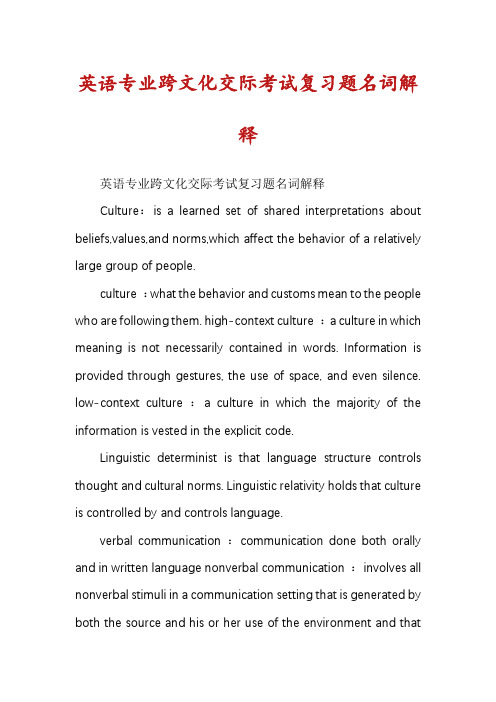
英语专业跨文化交际考试复习题名词解释英语专业跨文化交际考试复习题名词解释Culture:is a learned set of shared interpretations about beliefs,values,and norms,which affect the behavior of a relatively large group of people.culture :what the behavior and customs mean to the people who are following them. high-context culture :a culture in which meaning is not necessarily contained in words. Information is provided through gestures, the use of space, and even silence. low-context culture :a culture in which the majority of the information is vested in the explicit code.Linguistic determinist is that language structure controls thought and cultural norms. Linguistic relativity holds that culture is controlled by and controls language.verbal communication :communication done both orally and in written language nonverbal communication :involves all nonverbal stimuli in a communication setting that is generated by both the source and his or her use of the environment and thathas potential message value for the source or receiver.Individual Culture:Individuals tend to define themselves by the extent to which they are different from, rather than similar to other. People are encouraged to display self-confidence and assertiveness, disclosure of personal thoughts and feelings.collectivist culture:Collectivist cultures place little value on individual identity and great value on group identity. They have been labeled as “we” cultures because basic unit is the in-group or collective.Paralanguage refers to the rate ,pitch and volume qualities of the voice,which interrupt or temporarily take the place of speech and affect the meaning of a message. monochronic time (M Time) :It schedules one event at a time. In these cultures time is perceived as a linear structure just like a ribbon stretching from the past into the future.polychronic time (P Time) :schedules several activities at the same time. In these culture people emphasize the involvement of people more than schedules. They do not see appointments as ironclad commitments and often break them.ethnocentrism :the view of things in which one’s own group is the center of everything, and all others are scaled and ratedwith reference to it.Ethnocentrism is judging another culture solely by the values and standards of one's own culture. The ethnocentric individual will judge other groups relative to his or her own particular ethnic group or culture, especially with concern to language, behavior, customs, and religion. These ethnic distinctions and subdivisions serve to define each ethnicity's unique cultural identity.It refers to negatively judging aspects of another culture by the standards of one’s own culture.stereotypes :a form of generalization about some group of people, or a means of organizing images into fixed and simple categories that are used to stand for the entire collection of people.stereotypes:refers to negative or positive judgment made about individuals based on any observable or believed group membership.prejudice :It refers to negative attitudes towards other people that are based on faulty and inflexible stereotypes. It is an unfair, biased, or intolerant attitude towardsanother group of people.Prejudice refers to the irrational dislike,suspicion,or hatred ofa particular group,race,religion,or sexual orientation.culture shock :Troublesome feelings such as depression, loneliness, confusion, inadequacy, hostility, frustration, and tension, caused by the loss of familiar cues from the home culture.Culture shock refers to the traumatic experience that an individual may encounter when entering a different culture.culture shock: is the sense of dislocation and the problems, psychological and even physical, that result from the stress of trying to make the hundreds of adjustments necessary for living in a foreign culture.acculturation :It is culture change that results from continuous firsthand contact between two distinct cultural groups.Acculturation refers to an individual’s learning and adopting the norms and values of the new host culture.What is the author s view of the relationship between language and culture? Language and culture are clearly fused; one reflects the other.Language is related to culture in that language not only frames our thoughts but also reflects events that a particular culture experiences. For instance, the native people of Alaska have more than twenty words for snow. There can be seriousconsequences if one uses the wrong word in that certain words indicate how safe it is to travel under these snow conditions.In one of the Pacific Island tribes that I studied in Sociology, their counting system consisted of one, two and many. More than two items were many. Therefore they did not have the concept of “a dozen eggs."In some cultures they do not have words for certain emotions--such as love, fear, hate, etc. Thus in a culture that does not have the word fear, they would not build a theme park because the members of the culture would not experience the thrill of being "frightened" by the experience.。
跨文化交际复习考试题及答案
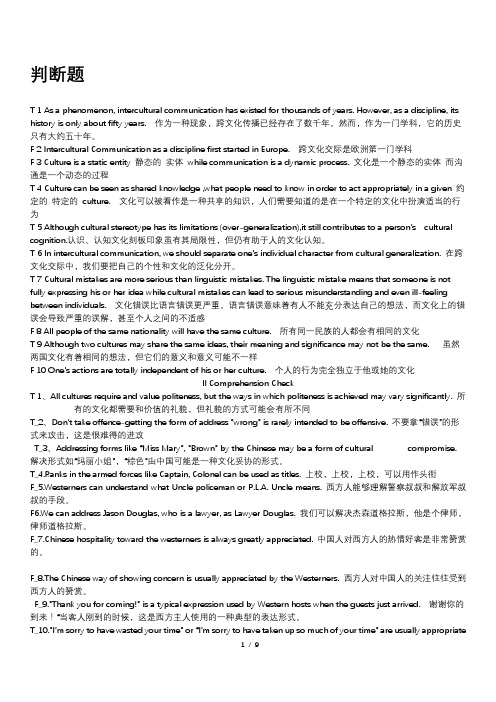
判断题T 1 As a phenomenon, intercultural communication has existed for thousands of years. However, as a discipline, its history is only about fifty years. 作为一种现象,跨文化传播已经存在了数千年。
然而,作为一门学科,它的历史只有大约五十年。
F 2 Intercultural Communication as a discipline first started in Europe. 跨文化交际是欧洲第一门学科F 3 Culture is a static entity 静态的实体while communication is a dynamic process. 文化是一个静态的实体而沟通是一个动态的过程T 4 Culture can be seen as shared knowledge ,what people need to know in order to act appropriately in a given 约定的特定的culture. 文化可以被看作是一种共享的知识,人们需要知道的是在一个特定的文化中扮演适当的行为T 5 Although cultural stereotype has its limitations (over-generalization),it still contributes to a person’s cultural cognition.认识、认知文化刻板印象虽有其局限性,但仍有助于人的文化认知。
T 6 In intercultural communication, we should separate one’s individual character from cultural generalization. 在跨文化交际中,我们要把自己的个性和文化的泛化分开。
跨文化交际导论期末考试题
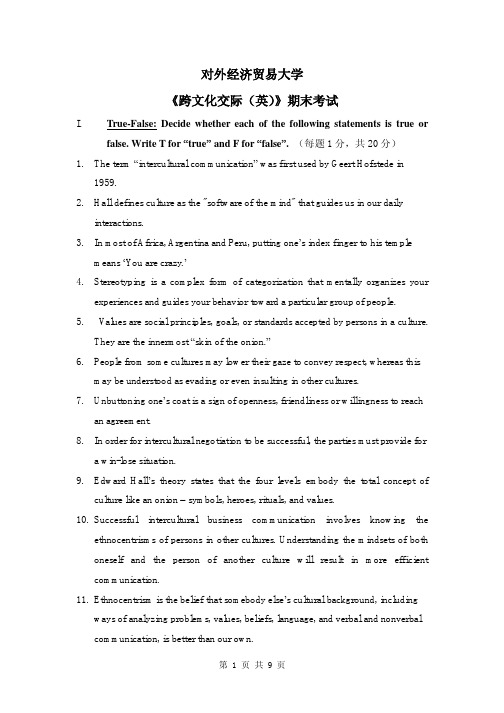
对外经济贸易大学《跨文化交际(英)》期末考试I.True-False: Decide whether each of the following statements is true orfalse. Write T for “true” and F for “false”.(每题1分,共20分)1.The term “intercultural communication” was first used by Geert Hofstede in1959.2.Hall defines culture as the "software of the mind" that guides us in our dailyinteractions.3.In most of Africa, Argentina and Peru, putting one’s index finger to his templemeans ‘You are crazy.’4.Stereotyping is a complex form of categorization that mentally organizes yourexperiences and guides your behavior toward a particular group of people.5.V alues are social principles, goals, or standards accepted by persons in a culture.They are the innermost “skin of the onion.”6.People from some cultures may lower their gaze to convey respect, whereas thismay be understood as evading or even insulting in other cultures.7.Unbuttoning one’s coat is a sign of openness, friendliness or willingness to reachan agreement.8.In order for intercultural negotiation to be successful, the parties must provide fora win-lose situation.9.Edward Hall’s theory states that the four levels embody the total concept ofculture like an onion – symbols, heroes, rituals, and values.10.Successful intercultural business communication involves knowing theethnocentrisms of persons in other cultures. Understanding the mindsets of both oneself and the person of another culture will result in more efficient communication.11.Ethnocentrism is the belief that somebody else’s cultural background, includingways of analyzing problems, values, beliefs, language, and verbal and nonverbal communication, is better than our own.12.People in the United States place a greater emphasis on history and do not likechange as compared with people of Asian and Latin cultures.13.When dealing with German business people, you should avoid jokes and otherforms of humor during the actual business sessions.14.In the business circle, American business people use first names immediately.panies should avoid sending female employees to the Middle East, as inArab countries men may refuse to work with women.16.In Southeast Asia, you should avoid presenting your business card with your righthand.17.When accepting a business card, German business people carefully look at thecard, observe the title and organization, acknowledge with a nod that they have digested the information, and perhaps make a relevant comment or ask a polite question.18.The OK sign may be interpreted as asking for money by Japanese businesspeople.19.Nonverbal communication is important to the study of interculturalcommunication because a great deal of nonverbal behavior speaks a universallanguage.20.In short, intercultural communication competence requires sufficient awarenessknowledge, motivations, and skills. Each of these components alone is sufficient to achieve intercultural communication competence.II.Translation: Translate the following Chinese terms into English and English terms into Chinese.(每题1分,共20分)1. stereotypes2. paralanguage3. ethnocentrism4. masculinity5. high-context culture6. monochronic time7. speech act 8. conversation taboos9. vocal qualifiers 10. power distance11. 译码12. 偏见13. 文化震惊14. 不确定性回避15. 概念意义16. 语用错误17. 礼貌原则18. 归纳法19. 空间语言20. 礼仪与礼节III.Multiple Choice: Choose the ONE appropriate answer.(每题1分,共20分)1. Understanding another culture ________.a.enables businesspeople to know why foreign associates believe and actas they dob.is best achieved through “do’s and don’ts” listsc.is important for businesspeople because they can appear to be betterinformedd.isn’t necessary for businesspeople2. Non-linear languages ______.a.are object orientedb.see time as a continuum of present, past and futurec.are circular, tradition oriented and subjectived.lead to short-range planning in business practices3. Which statement about values is incorrect?a. V alues are social principles, goals, or standards accepted by persons in aculture.b. V alues are learned by contacts with family members, teachers, andreligious leaders.c. V alues will be influenced by what is seen on television or read innewspapers.d. People in various cultures have basically similar values.4. People from cultures that follow the monochronic time system tend toa. do one thing at a time.b. be committed to people.c. borrow and lend things often.d. build lifetime relationships.5. Which statement regarding haptics is incorrect?a. In Thailand, it is offensive to touch the head.b. Japan is considered a "don't touch" culture.c. Greece is considered a "touch" culture.d. In Latin American countries, touching between men is unacceptable.6. The opinion that everyone has a position and clearly defined privileges is _____.a. a view of hierarchical structure of social relationshipb. a view of group orientation structure of social relationshipc. a view of individual orientation structure of social relationshipd.none of the above7. General guidelines to follow when conversing with someone from anotherculture include all of the following except:a. politics is a safe topic in most cultures.b. avoid telling jokes.c. avoid personal questions.d. keep the conversation positive.8. Which statement best describes an incorrect handshake?a. In the U.S., a handshake should be firm.b. An Asian handshake is usually gentle.c. Germans repeat a brusque handshake upon arrival and departure.d. A British handshake is firm and repeated frequently.9. Which statement referring to thought patterns is incorrect?a. Asians typically use the inductive method of reasoning.b. Thought patterns impact oral communication.c.When using the deductive method of reasoning, one starts with the factsand goes to generalizations.d. Recognizing different thought patterns is important in negotiation withdifferent cultures.10. Which statement is incorrect?a. Costly business blunders are often the result of a lack of knowledge ofanother culture's nonverbal communication patterns.b. Processes of reasoning and problem solving are the same in all cultures.c.Attitudes toward time and use of space convey nonverbal messages inintercultural encounters.d.When in another culture, an appropriate caution would be to watch thebehavior of the persons you are talking with and match their style.nguage is important because it _____a.helps us shape concepts, controls how we think, and controls how weperceive others.b.allows us to be understood by foreigners.c.is determined by colonialism.d.is stable, easily understood, and free of diversity.12. Which of the following countries uses high-context language?a.Canadab.Germanyc.Japand.United States13. Slang is generally _____a.understood by everyone.b.spoken by the masses.c.easily translated.ed by subgroups.14. Nonverbal communication does not include _____a. chromatics.b. chronemics.c.haptics.d. semantics.15. Dominance, harmony, and subjugation are all value orientations that correspond to which of the following cultural problems?a.What is the nature of human beings?b.What is the relationship of humans to nature?c.What is the orientation of humans to time?d.What is the human orientation to activity?16. Proverbs are significant to the study of intercultural communicationbecause_______.a.they provide a compact description of a culture’s valuesb.they tell a great deal about what a culture praises and what it rejectsc.they unite a people with the wisdom of their ancestorsd.all of the above17. Which statement highlights weak uncertainty avoidance?a. One group's truth should not be imposed on others.b. Scientific opponents cannot be personal friends.c. Citizen protest should be repressed.d. Negative attitudes are expressed toward young people.18. The main idea of the Sapir-Whorf Hypothesis is thatnguage is just a device for reporting a person's experience.b.two languages can represent the same social reality.c.the social reality can be conveyed to a person who does not speak thelanguage.nguage functions as a way of shaping a person's experience.19. Many multinational firms find that cultural shock can be alleviated bya. sending only top executives abroad.b. sending only young, single associates on overseas assignments.c. testing associates to see who is most qualified.d. selecting employees for overseas assignments who possess certainpersonal and professional qualifications.20. Which of the following statement is incorrect?a.Knowing cultural variations in the use of silence is helpful whenconversing with persons in another culture.b.We need to keep things in perspective and not get offended each time wedeal with someone who has a different attitude toward touchingc.Good advice when communicating with persons in other cultures is tokeep gestures to a minimumd.Although oral communication varies from culture to culture, non-verbalcommunication is almost always interpreted the same in each culture.IV.Answer the following essay question. (共20分)Compare and contrast the following proverbs from two different cultures: “It is the duck that squawks that gets shot”and “The squeaky wheel gets the grease.” How do people from these cultures perceive silence and talk? In light of their different perceptions, how might they view each other? What problems might arise in their interactions?V.Case Analysis: Analyze the following conversation from an intercultural perspective.(共20分)The following conversation took place between two Chinese friends.A: We’re going to New Orleans this weekend.B: What fun! I wish we were going with you. How long are you going to be there?A: Three days.B: Do you need a ride to the airport? I’ll take you.A: Are you sure it’s not too much trouble?B: No, no. It’s no trouble at all.Case Analysis: Analyze the following conversation from an intercultural perspective.参考答案及评分标准A卷VI.True-False: Decide whether each of the following statements is true or false. Write T for “true” and F for “false”.(每题1分,共20分)1. F2. F3. F4. T5. T6. T7. T8. F9. F 10. T11. F 12. F 13. T 14.T 15. T 16. F 17. F 18. T 19. T 20. FVII.Translation: Translate the following Chinese terms into English and English terms into Chinese.(每题1分,共20分)1. stereotypes 定势/刻板印象2. paralanguage 辅助语言/副语言3. ethnocentrism 民族中心主义4. masculinity男性特征5. high-context culture高语境文化6. monochronic time单一时间观念7. speech act 言语行为8. conversation taboos对话禁忌9. vocal qualifiers 声音修饰10. power distance权力距离11. 译码 decoding 12. 偏见 prejudice13. 文化震惊cultural shock 14. 不确定性回避 uncertaintyavoidance15. 概念意义denotational meaning 16. 语用错误pragmatic failure17. 礼貌原则the Politeness Principle 18. 归纳法inductivepattern19. 空间语言spatial language/proximics 20. 礼仪与礼节etiquetteand protocolVIII.Multiple Choice: Choose the ONE appropriate answer.(每题1分,共20分)1. a2. a3. d4. a5. d6. a7. a8. d9. c 10. b11. a 12. c 13. d 14. d 15. b 16. d 17. a 18. d 19. d 20. dIX.Answer the following essay question. (共20分)测试重点:Compare and contrast the proverbs “It is the duck that squawks thatgets shot”and “The squeaky wheel gets the grease.”The former is an English proverbwhile the latter is a Chinese proverb. In light of their different perceptions, the twocultures might differ in terms of silence and talk etc. and problems might arise in theirinteractions.评分标准:从以上角度进行分析,其他根据具体答题情况酌情。
- 1、下载文档前请自行甄别文档内容的完整性,平台不提供额外的编辑、内容补充、找答案等附加服务。
- 2、"仅部分预览"的文档,不可在线预览部分如存在完整性等问题,可反馈申请退款(可完整预览的文档不适用该条件!)。
- 3、如文档侵犯您的权益,请联系客服反馈,我们会尽快为您处理(人工客服工作时间:9:00-18:30)。
案例分析:英文第一篇1)Ms. Keen may feel that teachers should not accept gifts especially valuable one from students.2)Ms. Keen may feel that she only did her duties, so she doesn’t deserve such a special gift.3)Ms. Keen is afraid that other people will find out that she accepted the gift , and will think that she took a bribe.4)Ms. Keen may feel uncomfortable because she thinks Xiao Wang cannot afford to give expensive gifts.5)Ms. Keen may worry that if she accepts Xiao Wang's gift. she will owe him favors in the future.第二篇1)The taxi driver is trying to cheat Xiao Li because she is clearly a foreigner!2)There are extra charges for luggage that Xiao Li doesn't know about.3)There are extra charges for tolls that Xiao Li doesn't know about.4)There is an misunderstanding. Maybe there is something wrong with the meter or fares have gone up recently and the meter hasn’t been adjusted yet.5)Xiao Li misunderstood what the driver said, or didn't clearly hear what he said.6)The driver has included an unreasonably high tip for himself.7)The driver has included a tip for himself , perhaps because he thinks Xiao Li is a foreigner who doesn’t know that she should tip , or because in the past other foreigners have given him very stingy tips.8)The driver is trying to cheat Xiao Li because he is prejudiced against Asian people.第三篇1)HuiZhen actually doesn't make many mistakes, and Mr. Schmidt doesn't consider the few mistakes she makes serious.2)Mr. Schmidt doesn't notice Hui zhen's mistakes because he is paying more attention to the content of what she was saying.3)Mr. Schmidt doesn't correct Hui zhen because he doesn't want to interrupt her;he doesn't want to discourage her from talking.4)Mr. Schmidt thinks it would be rude to correct Hui zhen's English errors.3Mr. Schmidt does correct Hui zhen’s errors but he only corrects her subtly by repeating corrected versions of what she said wrong. However. Hui zhen doesn't notice this.6)Mr. Schmidt doesn't think that correcting students’ errors helps their English very mu ch.7)Mr. Schmidt avoids making grammar corrections because he can't explain English grammar very well.8)Mr. Schmidt doesn't take teaching very seriously especially grammar.第四篇1)The woman is just being polite; she really didn't think Xiao Feng's English was very good. 2)The woman was genuinely impressed by Xiao Feng's ability to handle such a difficult topic, even though he made some errors.3)The woman could tell Xiao Feng was having difficulty with his English, and she wanted to encourage him.4)The woman feels a little awkward because she put Xiao Feng through so much trouble, and compliment is really another way of saying thank you.第五篇1) Ms. Merrick is surprised, and perhaps a little annoyed, because Xiao Yang didn'tlet her know she was coming.2) Ms. Merrick isn't annoyed that Xiao Yang came by, although she is a littleannoyed that she now has to turn Xiao Yang away. However. she has planned to do something else this evening and isn't going to change her plan just because XiaoYang came by.3) Ms. Merrick's invitations were meant to be polite more than serious. and shereally didn't want Xiao Yang to visit.4)Ms. Merrick was in a bad mood for reasons unrelated to Xiao Yang's visit.Perhaps she didn't feel well, or something unpleasant had happened.5)Ms. Merrick is not really unhappy to see Xiao Yang. but for some reason this wasan inconvenient time and she was caught off guard. At another time she would behappy to see Xiao Yang.6)Merrick doesn’t have any specific plan for the evening but was lookingforward to a free evening, and was disappointed when Xiao Yang showed up (Shelikes Xiao Yang, but sees Xiao Yang as a student, hence as part of her work life.)第六篇1)They are quite happy just living together and don't see any strong reason to get married.2)They like each other but don't marry because they still aren’t sure if they have found the right partner for the rest of their lives.3)They are not serious enough about the relationship to consider marriage.4)They like each other, but marriage would get in the way of their careers or some other aspect of their lives which they feel is more important than a life-long commitment to a partner.5)They will probably get married eventually, but feel little pressure to go through the formalities of a wedding, and are delaying the cost and trouble a weddinginvolves.6)They don’t want to talk with Li Ming about this personal topic because they don’t know her very well. They are trying to end discussion of this topic.7)They don't want to talk with Li Ming much about their personal plans because this is a sensitive issue or a point of contention between them. They are trying to end discussion of this topic.案列分析:中文第一篇1)女士。
